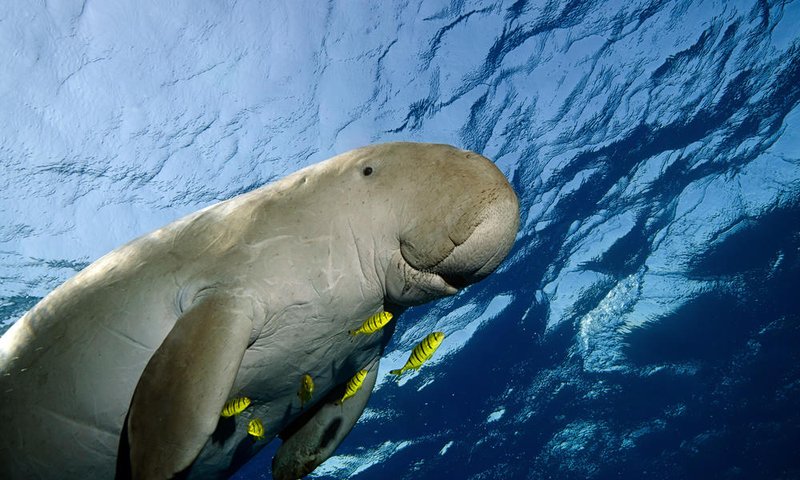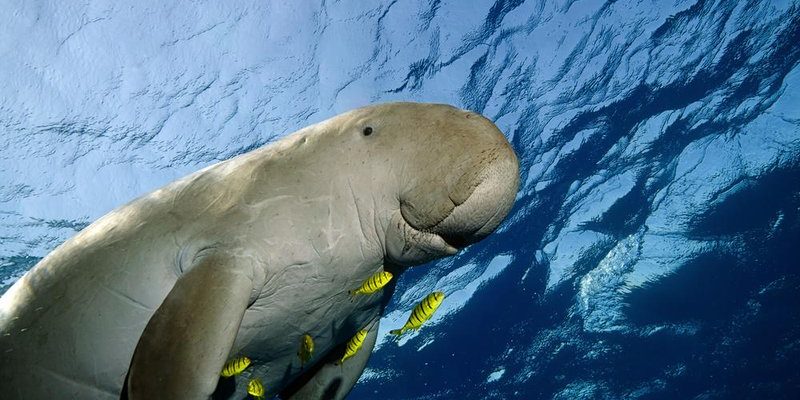
Here’s the thing: the dugong is not your typical sea monster. Unlike sharks or jellyfish, this herbivore isn’t known for aggressive behavior. But, as with any wild animal, there’s always a sliver of unpredictability. Let me explain more about the dugong, its habits, and whether it can be dangerous to us mere mortals who sometimes swim in its domain.
What is a Dugong?
Dugongs are large, marine mammals that belong to the same family as manatees. They can grow up to 10 feet long and weigh around 1,000 pounds. These gentle giants are often nicknamed “sea cows” because of their diet, which mainly consists of seagrass. Picture them munching leisurely, like a cow grazing in a field.
These animals are mostly found in warm coastal waters, particularly in the Indian and western Pacific Oceans. Dugongs have a unique shape—think of a streamlined body with a fluked tail and paddle-like flippers. Their skin is a grayish color, usually covered with barnacles or other organisms, showing just how much time they spend in the ocean.
Living in small groups, dugongs are social creatures. They can often be spotted swimming together, and they communicate via chirps, whistles, and other sounds. But before you think they’re entirely harmless, it’s important to delve deeper into their behavior.
Are Dugongs Aggressive?
Honestly, dugongs are not known for their aggressive behavior. These creatures are more like shy giants. They tend to avoid confrontations and prefer to retreat from threats. Generally, they are gentle and docile, which makes them a delight to observe in their natural habitat.
However, like any wild animal, dugongs can feel threatened, especially when humans invade their space. If they feel cornered or disturbed—say, by a boat or a curious swimmer—they may act unpredictably. This could lead to an accidental injury due to their size or the powerful swipes of their flippers.
It’s important to remember that dugongs are not inherently dangerous. They don’t have sharp teeth like some other marine animals. But if startled or provoked, they can react. So, treating them with respect and giving them their space is essential.
Potential Risks When Encountering Dugongs
When swimming or boating near dugongs, it’s always smart to keep a safe distance. Here are some potential risks to be aware of:
- Boat Collisions: One of the bigger dangers to dugongs comes from boats. Sadly, these creatures can be struck, causing injuries or even death.
- Human Interaction: If you get too close, a startled dugong might accidentally hit you while trying to swim away. Their size can lead to accidental injuries.
- Habitat Degradation: Pollution and coastal development can harm dugongs and their habitats, leading to stress in the populations. This can result in unusual behaviors, making encounters unpredictable.
Each of these risks highlights the importance of respecting dugongs and their environment. While they’re usually harmless, their safety—and ours—depends on making smart choices.
How to Safely Observe Dugongs
If you’re lucky enough to spot a dugong, you likely want to take it all in without being intrusive. Here are some tips for safe dugong observation:
- Maintain Distance: Use binoculars for a closer look instead of swimming right up to them.
- Respect Their Space: If you’re in a boat, keep a good distance. Dugongs are more likely to feel safe and comfortable if you’re not directly in their path.
- Educate Others: Share your knowledge with fellow boaters and swimmers about the importance of protecting these gentle giants.
By following these guidelines, you can enjoy watching dugongs without causing them stress or putting yourself at risk.
Why Dugongs Matter to the Ecosystem
Dugongs play a vital role in coastal ecosystems. By feeding on seagrass, they help maintain healthy underwater habitats. Here’s how:
- Seagrass Health: Their grazing helps keep seagrass beds healthy and flourishing, preventing overgrowth.
- Habitat for Other Species: Seagrass beds provide shelter and food for various fish and marine life.
- Biodiversity: Healthy seagrass ecosystems contribute to overall biodiversity, which is essential for robust marine environments.
By protecting dugongs, we also protect their habitat and the countless other marine species that rely on healthy seagrass beds.
Conservation and the Future of Dugongs
Sadly, dugongs face various threats, from hunting to habitat loss. Conservation efforts are crucial to ensuring these unique creatures don’t disappear. Many organizations work tirelessly to protect dugongs and educate the public about their importance.
You might be wondering how you can help. Here are a few steps you can take:
- Support Conservation Initiatives: Donate to organizations that focus on marine mammal protection.
- Practice Responsible Boating: Always follow local guidelines for boating in areas where dugongs are known to live.
- Raise Awareness: Share information about dugongs with friends and family to encourage more people to protect these wonderful creatures.
Every little effort counts when it comes to conservation.
So, can the dugong be dangerous to humans? The short answer is no, but like any wild animal, caution is always wise. Digging into the habits and importance of dugongs shows just how special these creatures are. They are gentle, play a crucial role in their ecosystem, and deserve our respect.
Next time you’re near the water, take a moment to appreciate these magnificent sea cows. With a little understanding and respect, you can enjoy the beauty of dugongs while ensuring their safety—and yours.

